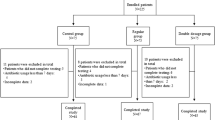Summary
A differential quantitative analysis was used to study the effect of cefotaxime on the fecal flora in 26 hospitalized children ranging from two days to four years of age. Fecal specimens were obtained before, during and after therapy. This study was evaluated in comparison to 41 patients of the same age and from the same environment without antibiotic treatment or signs of infection. The fecal flora of the control group showed qualitative and quantitative stability. Two groups of species were distinguished: a group in which the upper limit was ≤107 bacteria/g of stool(Klebsiella, Enterobacter, other enterobacteria,Staphylococcus, Pseudomonas) and a group with ≤1010 bacteria/g of stool (anaerobes,Escherichia coli, Streptococcus D). This stability of the control group of subjects allowed us to interpret the variations of microbial concentrations during and after cefotaxime treatment. In previous studies, we showed in the newborn a substantial risk of septicemia of intestinal origin when over-growth occured, especially withKlebsiella. With cefotaxime there was a decrease or a disappearance in 65% ofE. coli and a slight decrease ofKlebsiella andEnterobacter. This fact was of great interest in the treatment of endogenous secondary septicemia. We observed an appearance ofPseudomonas (ninePseudomonas aeruginosa, twoPseudomonas putida, onePseudomonas fluorescens) in 12 cases among the 26 children treated. For eight strains, the bacterial levels did not differ from those of the control population. Four strains ofPseudomonas appeared with more than 106 cells/g of stool, but no systemic infection occurred. No other significant changes were found in the remaining bacteria and there was no selection of resistant organisms.
Zusammenfassung
Die Wirkung von Cefotaxim auf die Stuhlflora bei 26 stationär behandelten Kindern im Alter von zwischen zwei Tagen und vier Jahren wurde mit einer differenzierenden quantitativen Analyse untersucht. Stuhlproben wurden vor, während und nach der Therapie abgenommen. Diese Studie wurde im Vergleich zu 41 Patienten der gleichen Altersgruppe und Umgebung, jedoch ohne Antibiotika-Behandlung oder Anzeichen einer Infektion ausgewertet. Die Untersuchung der Stuhlflora der Kontrollgruppe zeigte qualitative und quantitative Stabilität. Es wurden zwei Gruppen unterschieden: eine Gruppe, die in Konzentration von ≤107 Bakterien/g Stuhl vorkamen(Klebsiella, Enterobacter, andere Enterobakterien,Staphylococcus, Pseudomonas) und eine Gruppe mit ≤1010 Bakterien/g Stuhl (Anaerobier,Escherichia coli, Streptococcus D). Diese Stabilität der Kontrollgruppe erlaubte uns, die Schwankungen der Bakterien-Konzentrationen während und nach der Cefotaxim-Behandlung zu interpretieren. In früheren Studien zeigten wir, daß beim Neugeborenen bei Überwucherung, insbesondere durchKlebsiella, beträchtliche Gefahr einer Sepsis intestinalen Ursprungs bestand. Mit Cefotaxim wurde bei 65% der Patienten eine Verminderung oder ein Verschwinden vonE. coli und ein leichter Rückgang vonKlebsiella undEnterobacter festgestellt. Diese Tatsache war von großem Interesse bei der Behandlung endogener sekundärer Sepsisfälle. Unter den 26 behandelten Kindern beobachteten wir 12 Fälle vonPseudomonas (9Pseudomonas aeruginosa, 2Pseudomonas putida, 1Pseudomonas fluorescens). In acht Fällen unterschied sich die Bakterienflora nicht von der Kontrollgruppe. Vier Fälle von Pseudomonasbesiedelung traten auf mit über 106 Keimen/g Stuhl, jedoch ohne systemische Infektion. Bei den übrigen Bakterien wurden keine bedeutungsvollen Veränderungen gefunden, und es gab keine Selektion resistenter Organismen.
Similar content being viewed by others
Literature
Lambert-Zechovsky, N., Bingen, E., Aufrant, C., Proux, M. C. Bacteriological and clinical criteria for cefotaxime treatment in pediatrics. Drugs. Exp. Clin. Res. 7 (1981) 385–390.
Sutter, V. L., Finegold, S. M. The effects of antimicrobial agents on human fecal flora: studies with cephalexin, cyclacillin and clindamycin. In:Skinner, F. A., Carr, J. G. (eds): The normal microbial flora of man. The society of applied bacteriology symposium, Academic Press Inc., London 1974, pp. 229–240.
Lambert-Zechovsky, N., Bingen, E., Beaufils, F., Bourrillon, A., Mathieu, H. Etude de l'écosystème intestinal de l'enfant — Influence de la colistine. Pathol. Biol. 29 (1981) 293–297.
Finland, M. Changing ecology of bacterial infections as related to antimicrobial therapy. J. Infect. Dis. 122 (1970) 419–423.
Bingen, E., Lambert-Zechovsky, N. Technical aspects of the quantitative and differential analysis of the microbial intestinal ecosystem. Dev. Pharmacol. Ther. 7 Suppl. 1 (1984) 134–137.
Sutter, V. L., Citron, D. M., Finegold, S. M. Wadsworth anaerobic bacteriology manual. 3rd ed. C. V. Mosby, St. Louis 1980.
Lennette, E. M., Balows, A., Hausler, Jr. W. J., Truant, J. P. Manual of clinical microbiology, 3rd. ed. American Society for Microbiology, Washington D. C. 1980.
Mathieu, H., Lambert-Zechovsky, N., Bourrillon, A., Bingen, E., Aujard, Y., Beaufils, F. Antibiotic therapy and bacterial overgrowth in intestinal microbial ecosystem: a major risk of secondary infections in newborns. Dev. Pharmacol. Ther. 7 Suppl. 1 (1984) 158–163.
Sykes, P. A., Boulter, K. H., Schofield, P. F. The microflora of the obstructed bowel. Br. J. Surg. 63 (1976) 721–726.
Wade, J. C., Schimpf, S. C., Hardagon, M. T., Fortner, C. L., Young, V. M., Wiernik, P. H. A comparison of trimethoprim-sulfamethoxazole plus nystatin with gentamicin plus nystatin in the prevention of infections in acute leukemia. N. Engl. J. Med. 304 (1981) 1057–1062.
Lambert-Zechovsky, N., Bingen, E., Beaufils, F., Bidault, F., Bourrillon, A., Mathieu, H. Risque infectieux et antibiothérapie en milieu pédiatrique. Appréciation par l'étude de l'écosystème bactérien intestinal. Méd. Mal. Infect. 9 (1979) 626–635.
Bourrillon, A., Brackman, D., Boussougant, Y., de Paillerets, F. Cefotaxime effects on the intestinal flora of the newborn. Dev. Pharmacol. Ther. 7 Suppl. 1 (1984) 144–149.
Yu, V. L. Enterococcal superinfection and colonization after therapy with moxalactam, a new broad-spectrum antibiotic. Ann. Intern. Med. 9 (1981) 784–785.
Patel, I. H., Chen, S., Parsonnet, M., Hackman, M. R., Brooks, M. A., Konikoff, J., Kaplan, S. A. Pharmacokinetics of ceftriaxone in humans. Antimicrob. Agents Chemother. 20 (1981) 634–641.
Bodey, G. P., Fainstein, V., Garcia, I., Rosenbaum, B., Wong, Y. Effect of broad-spectrum cephalosporins on the microbial flora of recipients. J. Infect. Dis. 148 (1983) 892–897.
Alestig, K., Carlsberg, H., Nord, C. E., Trollfors, B. Effect of cefoperazone on faecal flora. J. Antimicrob. Chemother. 12 (1983) 163–167.
Author information
Authors and Affiliations
Rights and permissions
About this article
Cite this article
Lambert-Zechovsky, N., Bingen, E., Aujard, Y. et al. Impact of cefotaxime on the fecal flora in children. Infection 13 (Suppl 1), S140–S144 (1985). https://doi.org/10.1007/BF01644236
Issue Date:
DOI: https://doi.org/10.1007/BF01644236




